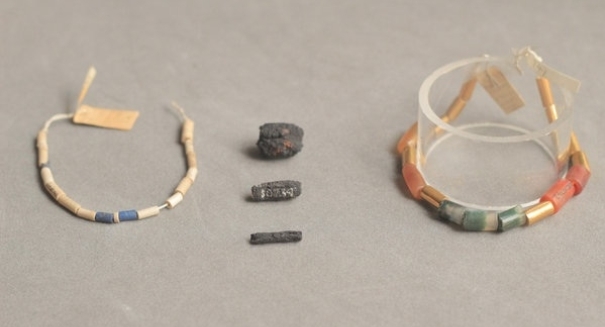
The nine beads were already completely rusted when they were found.
Researchers at the University College London (UCL) have traced the origins of ancient Egyptian beads at the UCL Petrie Museum to outer space. Thus, they have determined that the beads were not constructed from iron ore, but made from pieces of meteorites. According to a news release from the UCL, the beads prefaced the entrance of iron smelting by 2,000 years.
The nine beads, which are more than 5,000 years old, were initially strung into a necklace together with other interesting minerals like gold and gemstones. The intermingling of the nine beads with other exotic minerals shows the high value of space jewelry in ancient times.
According to the UCL, iron was a metal of mythical character in ancient Egyptian society. It was known as the “metal of heaven,” because ancient Egyptians recognized the fact that it came from meteoric iron. Long before the Egyptians learned to smelt iron ore, they were making beads from it, gathering the metal from fallen meteorites.
“The shape of the beads was obtained by smithing and rolling, most likely involving multiple cycles of hammering, and not by the traditional stone-working techniques such as carving or drilling which were used for the other beads found in the same tomb,” said lead author Thilo Rehren of the UCL.
The study’s findings reveal that in the fourth millennium BC metalworkers had already become experts at the smithing of meteoritic iron, forming techniques that went on to typify the iron age.
Thus, metalworkers had a long history of working with meteoritic iron when iron smelting took center stage in the mid-second millennium BC. According to the researchers, this background was crucial for the advancement of iron smelting and the creation of iron from iron ore, allowing iron to become the primary metal used.
The nine beads were already completely rusted when they were found. Thus, the team turned to x-ray techniques to decide whether the beads were actually meteoric iron, and not magnetite, which can frequently be confused with rusted iron.
Using the x-ray techniques, the researchers uncovered the unique surface characteristics as well as high concentration of nickel, cobalt, phosphorous and germanium that is suggestive of meteoric iron.
“The really exciting outcome of this research is that we were for the first time able to demonstrate conclusively that there are typical trace elements such as cobalt and germanium present in these beads, at levels that only occur in meteoritic iron,” said Rehren.
“We are also excited to be able to see the internal structure of the beads, revealing how they were rolled and hammered into form. This is very different technology from the usual stone bead drilling, and shows quite an advanced understanding of how the metal smiths worked this rather difficult material.”
The study’s findings are published in the Journal of Archaeological Science.

Leave a Reply